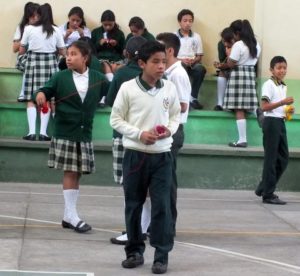The photo above was taken at a junior high school in Guatemala where the government only provides free education through the sixth grade. Can you tell from the picture which kids are there on scholarships? Would you be able to pick out which boys have to wash their own shirt every day and spread it on a bush to dry because their mothers are working too hard to help feed their families to do it for them? Is it apparent which girls would likely be married as young teenagers if they weren’t able to go to school?
It isn’t easy being a kid in any country these days. They need all the help they can get to cope with life in our highly competitive world. From bullying to broken homes, religious and racial discrimination, and wearable symbols of wealth like expensive tennis shoes and clothes that feature a highly visible brand name, the peer pressures children face on a daily basis are almost incomprehensible to those of us who grew up before the introduction of Facebook and cell phones. 
So what’s a parent to do? How can they help their kids cope with reality? It’s obvious there are no magic formulas to cover all those pressures, but school uniforms can have a significant impact on behavior, as well as on leveling the playing field between haves and have nots.
School uniforms? Yes, school uniforms. Anything that helps children feel they are equal to their classmates is worth considering.
Throughout Africa and the Caribbean, Central and South America, Israel, Australia and beyond, as well as in a growing number of schools in the U.S., students wear uniforms to school. They are a visual symbol of equality that can make a daily difference in a child’s life. Growing up as a poor child in a rich kid’s school, I desperately wanted to be able to dress like my classmates. Because that could only happen in my dreams, it was obvious from my appearance that my family’s economic status was far different from theirs.
I know my experiences at school had an impact on the way I felt about myself then and the way I lead my life today. How about you? What symbols of equality do you struggle with?
By Judy Osgood